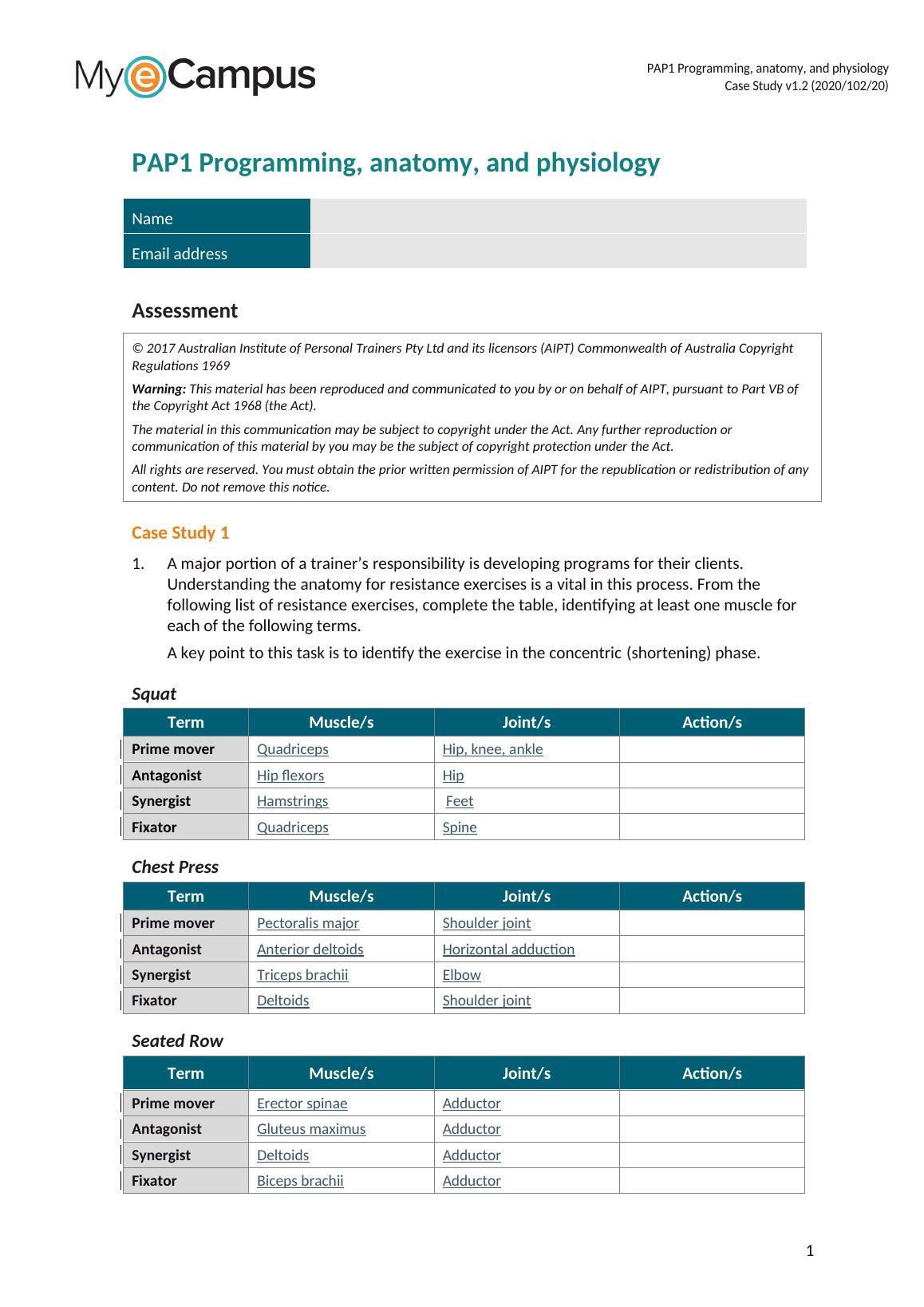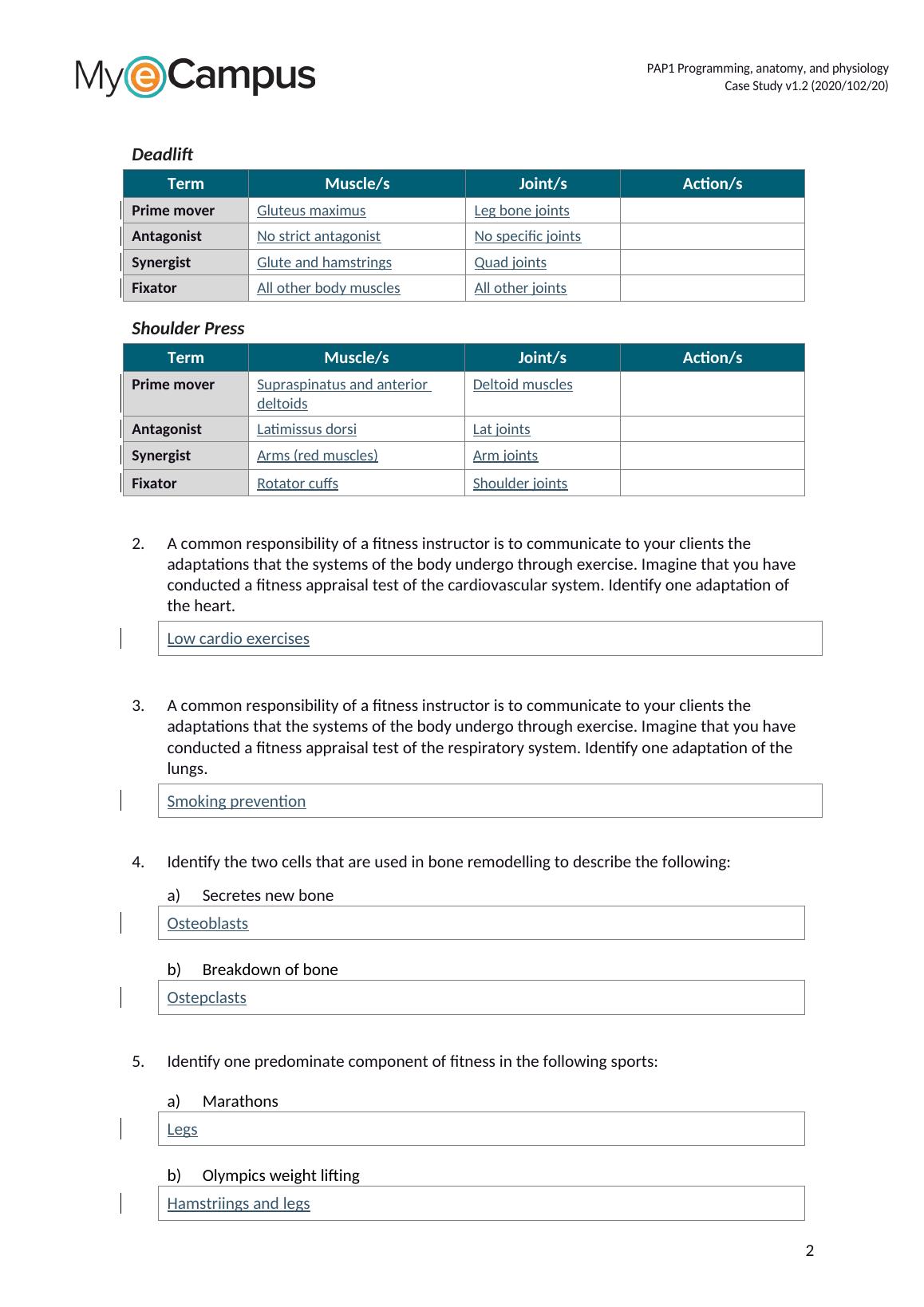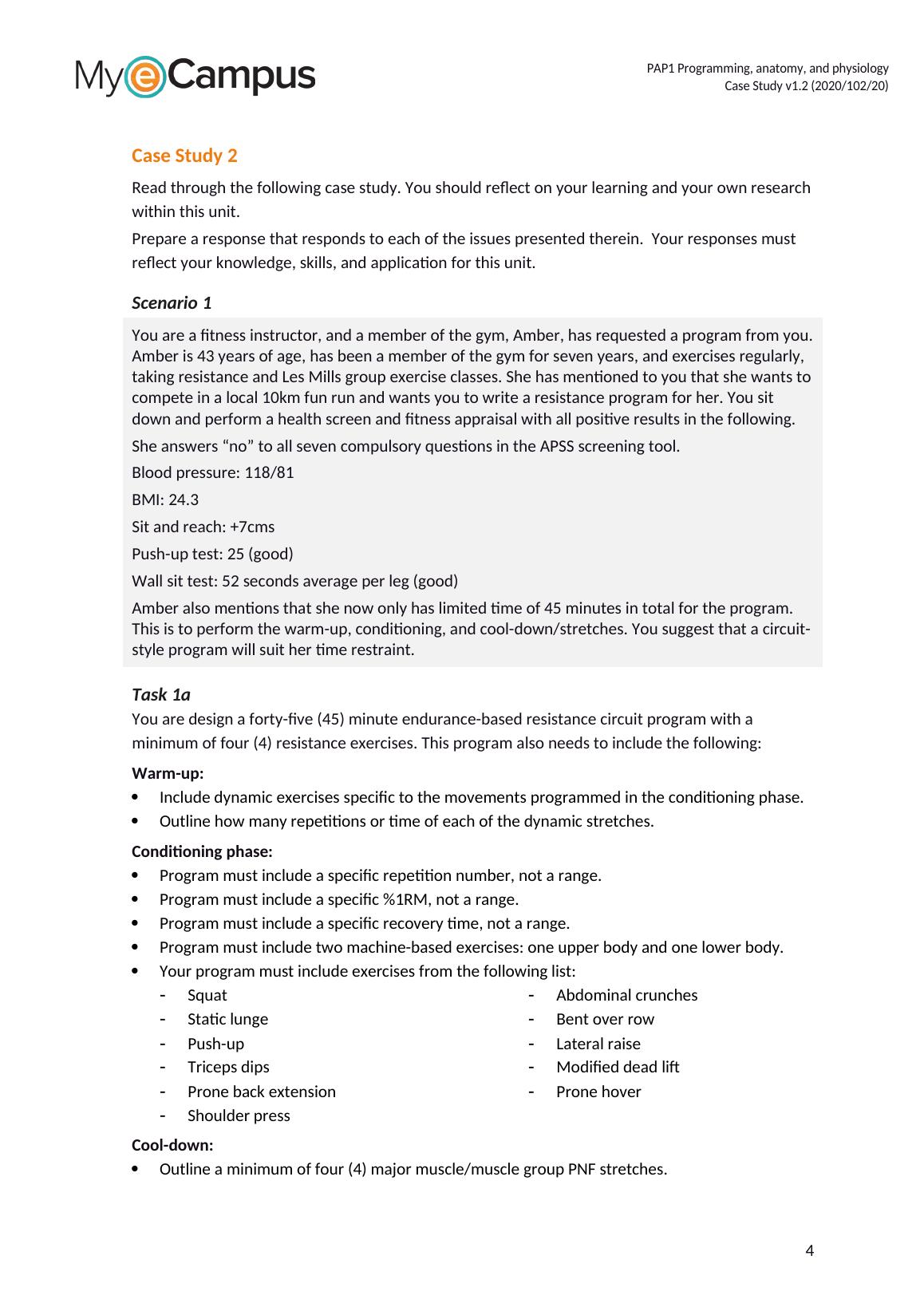PAP1 Programming, anatomy, and physiology docx.
Added on 2022-08-13
15 Pages2768 Words16 Views
PAP1 Programming, anatomy, and physiology
Case Study v1.2 (2020/102/20)
PAP1 Programming, anatomy, and
physiology
Name
Email address
Assessment© 2017 Australian Institute of Personal Trainers Pty Ltd and its licensors (AIPT) Commonwealth
of Australia Copyright Regulations 1969
Warning: This material has been reproduced and communicated to you by or on behalf of AIPT,
pursuant to Part VB of the Copyright Act 1968 (the Act).
The material in this communication may be subject to copyright under the Act. Any further
reproduction or communication of this material by you may be the subject of copyright
protection under the Act.
All rights are reserved. You must obtain the prior written permission of AIPT for the republication
or redistribution of any content. Do not remove this notice.
Case Study 1
1. A major portion of a trainer’s responsibility is developing programs for
their clients. Understanding the anatomy for resistance exercises is a vital
in this process. From the following list of resistance exercises, complete
the table, identifying at least one muscle for each of the following terms.
A key point to this task is to identify the exercise in the concentric
(shortening) phase.Squat
Term Muscle/s Joint/s Action/s
Prime
mover
Quadriceps Hip, knee, ankle
Antagonist Hip flexors Hip
Synergist Hamstrings Feet
Fixator Quadriceps SpineChest Press
Term Muscle/s Joint/s Action/s
Prime
mover
Pectoralis major Shoulder joint
Antagonist Anterior deltoids Horizontal adduction
Synergist Triceps brachii Elbow
Fixator Deltoids Shoulder jointSeated Row
Term Muscle/s Joint/s Action/s
Prime
mover
Erector spinae Adductor
1
Case Study v1.2 (2020/102/20)
PAP1 Programming, anatomy, and
physiology
Name
Email address
Assessment© 2017 Australian Institute of Personal Trainers Pty Ltd and its licensors (AIPT) Commonwealth
of Australia Copyright Regulations 1969
Warning: This material has been reproduced and communicated to you by or on behalf of AIPT,
pursuant to Part VB of the Copyright Act 1968 (the Act).
The material in this communication may be subject to copyright under the Act. Any further
reproduction or communication of this material by you may be the subject of copyright
protection under the Act.
All rights are reserved. You must obtain the prior written permission of AIPT for the republication
or redistribution of any content. Do not remove this notice.
Case Study 1
1. A major portion of a trainer’s responsibility is developing programs for
their clients. Understanding the anatomy for resistance exercises is a vital
in this process. From the following list of resistance exercises, complete
the table, identifying at least one muscle for each of the following terms.
A key point to this task is to identify the exercise in the concentric
(shortening) phase.Squat
Term Muscle/s Joint/s Action/s
Prime
mover
Quadriceps Hip, knee, ankle
Antagonist Hip flexors Hip
Synergist Hamstrings Feet
Fixator Quadriceps SpineChest Press
Term Muscle/s Joint/s Action/s
Prime
mover
Pectoralis major Shoulder joint
Antagonist Anterior deltoids Horizontal adduction
Synergist Triceps brachii Elbow
Fixator Deltoids Shoulder jointSeated Row
Term Muscle/s Joint/s Action/s
Prime
mover
Erector spinae Adductor
1

PAP1 Programming, anatomy, and physiology
Case Study v1.2 (2020/102/20)
Antagonist Gluteus maximus Adductor
Synergist Deltoids Adductor
Fixator Biceps brachii AdductorDeadlift
Term Muscle/s Joint/s Action/s
Prime
mover
Gluteus maximus Leg bone joints
Antagonist No strict antagonist No specific joints
Synergist Glute and hamstrings Quad joints
Fixator All other body muscles All other jointsShoulder Press
Term Muscle/s Joint/s Action/s
Prime
mover
Supraspinatus and
anterior deltoids
Deltoid muscles
Antagonist Latimissus dorsi Lat joints
Synergist Arms (red muscles) Arm joints
Fixator Rotator cuffs Shoulder joints
2. A common responsibility of a fitness instructor is to communicate to your
clients the adaptations that the systems of the body undergo through
exercise. Imagine that you have conducted a fitness appraisal test of the
cardiovascular system. Identify one adaptation of the heart.
Low cardio exercises
3. A common responsibility of a fitness instructor is to communicate to your
clients the adaptations that the systems of the body undergo through
exercise. Imagine that you have conducted a fitness appraisal test of the
respiratory system. Identify one adaptation of the lungs.
Smoking prevention
4. Identify the two cells that are used in bone remodelling to describe the
following:
a) Secretes new bone
Osteoblasts
b) Breakdown of bone
Ostepclasts
5. Identify one predominate component of fitness in the following sports:
a) Marathons
2
Case Study v1.2 (2020/102/20)
Antagonist Gluteus maximus Adductor
Synergist Deltoids Adductor
Fixator Biceps brachii AdductorDeadlift
Term Muscle/s Joint/s Action/s
Prime
mover
Gluteus maximus Leg bone joints
Antagonist No strict antagonist No specific joints
Synergist Glute and hamstrings Quad joints
Fixator All other body muscles All other jointsShoulder Press
Term Muscle/s Joint/s Action/s
Prime
mover
Supraspinatus and
anterior deltoids
Deltoid muscles
Antagonist Latimissus dorsi Lat joints
Synergist Arms (red muscles) Arm joints
Fixator Rotator cuffs Shoulder joints
2. A common responsibility of a fitness instructor is to communicate to your
clients the adaptations that the systems of the body undergo through
exercise. Imagine that you have conducted a fitness appraisal test of the
cardiovascular system. Identify one adaptation of the heart.
Low cardio exercises
3. A common responsibility of a fitness instructor is to communicate to your
clients the adaptations that the systems of the body undergo through
exercise. Imagine that you have conducted a fitness appraisal test of the
respiratory system. Identify one adaptation of the lungs.
Smoking prevention
4. Identify the two cells that are used in bone remodelling to describe the
following:
a) Secretes new bone
Osteoblasts
b) Breakdown of bone
Ostepclasts
5. Identify one predominate component of fitness in the following sports:
a) Marathons
2

PAP1 Programming, anatomy, and physiology
Case Study v1.2 (2020/102/20)
Legs
b) Olympics weight lifting
Hamstriings and legs
c) Cross-country skiing
Hips and strong legs
d) Strongman competitions
Overall body strength
6. Complete the following sentence describing the nervous system and its
relationship with the muscular system by adding the correct missing
words.
Tempor
al
summation is the process by which an
increase in
action of
potentials (or firing frequency) causes an increase in
the amount of
ATP
generated by the
individual
unit.
7. Identify the digestive system processes and the fuel source that the
process metabolises.
a) Glycolysis
Carbohydrates
b) Lipolysis
Lipids
8. Complete the following table by adding the muscles involved at rest and
during exercise during respiration.
At rest During exercise
Inspirati
on
Diaphragm External intercostals
Expiratio
n
internal intercostals, rectus
abdominis, external
internal obliques, transversus
abdominis
9. Understanding the role and importance of the energy systems of the body
is vital to understanding how the body can adapt to exercise as well as
how it can influence the duration of exercise sessions. In the following
table, arrange in correct order the energy system to their energy
substrate, duration of energy system, and waste products
Energy
system
Duration of
maximal
Energy
substrate/s
Waste
product/s
3
Case Study v1.2 (2020/102/20)
Legs
b) Olympics weight lifting
Hamstriings and legs
c) Cross-country skiing
Hips and strong legs
d) Strongman competitions
Overall body strength
6. Complete the following sentence describing the nervous system and its
relationship with the muscular system by adding the correct missing
words.
Tempor
al
summation is the process by which an
increase in
action of
potentials (or firing frequency) causes an increase in
the amount of
ATP
generated by the
individual
unit.
7. Identify the digestive system processes and the fuel source that the
process metabolises.
a) Glycolysis
Carbohydrates
b) Lipolysis
Lipids
8. Complete the following table by adding the muscles involved at rest and
during exercise during respiration.
At rest During exercise
Inspirati
on
Diaphragm External intercostals
Expiratio
n
internal intercostals, rectus
abdominis, external
internal obliques, transversus
abdominis
9. Understanding the role and importance of the energy systems of the body
is vital to understanding how the body can adapt to exercise as well as
how it can influence the duration of exercise sessions. In the following
table, arrange in correct order the energy system to their energy
substrate, duration of energy system, and waste products
Energy
system
Duration of
maximal
Energy
substrate/s
Waste
product/s
3

PAP1 Programming, anatomy, and physiology
Case Study v1.2 (2020/102/20)
energy
production
ATP-CP Long time ADP and Pi Metabolites
Lactic
energy
system
Short time Lactate Metabolites
Aerobic
energy
system
long time Carbohydrates Metabolites
4
Case Study v1.2 (2020/102/20)
energy
production
ATP-CP Long time ADP and Pi Metabolites
Lactic
energy
system
Short time Lactate Metabolites
Aerobic
energy
system
long time Carbohydrates Metabolites
4

End of preview
Want to access all the pages? Upload your documents or become a member.
